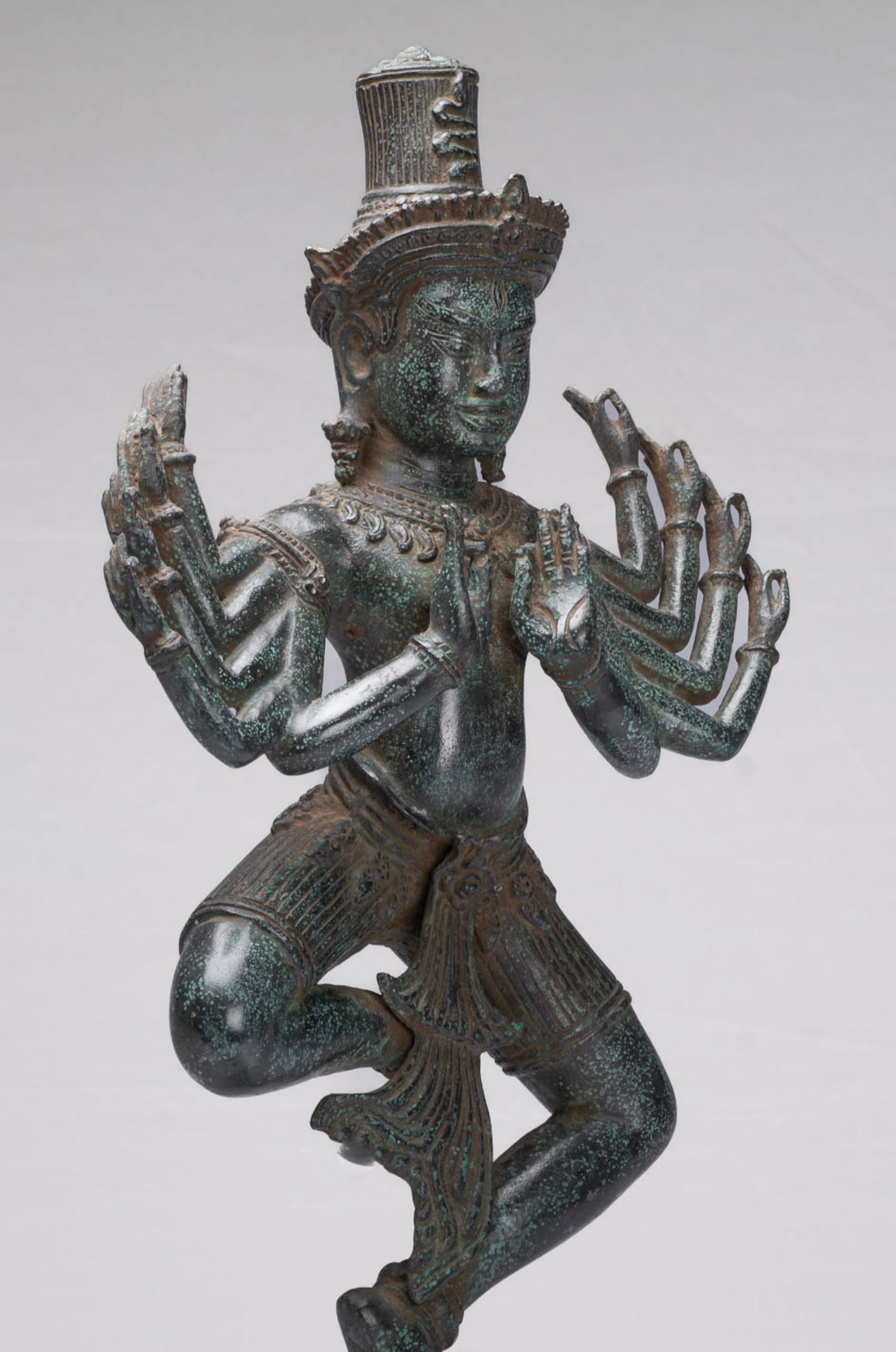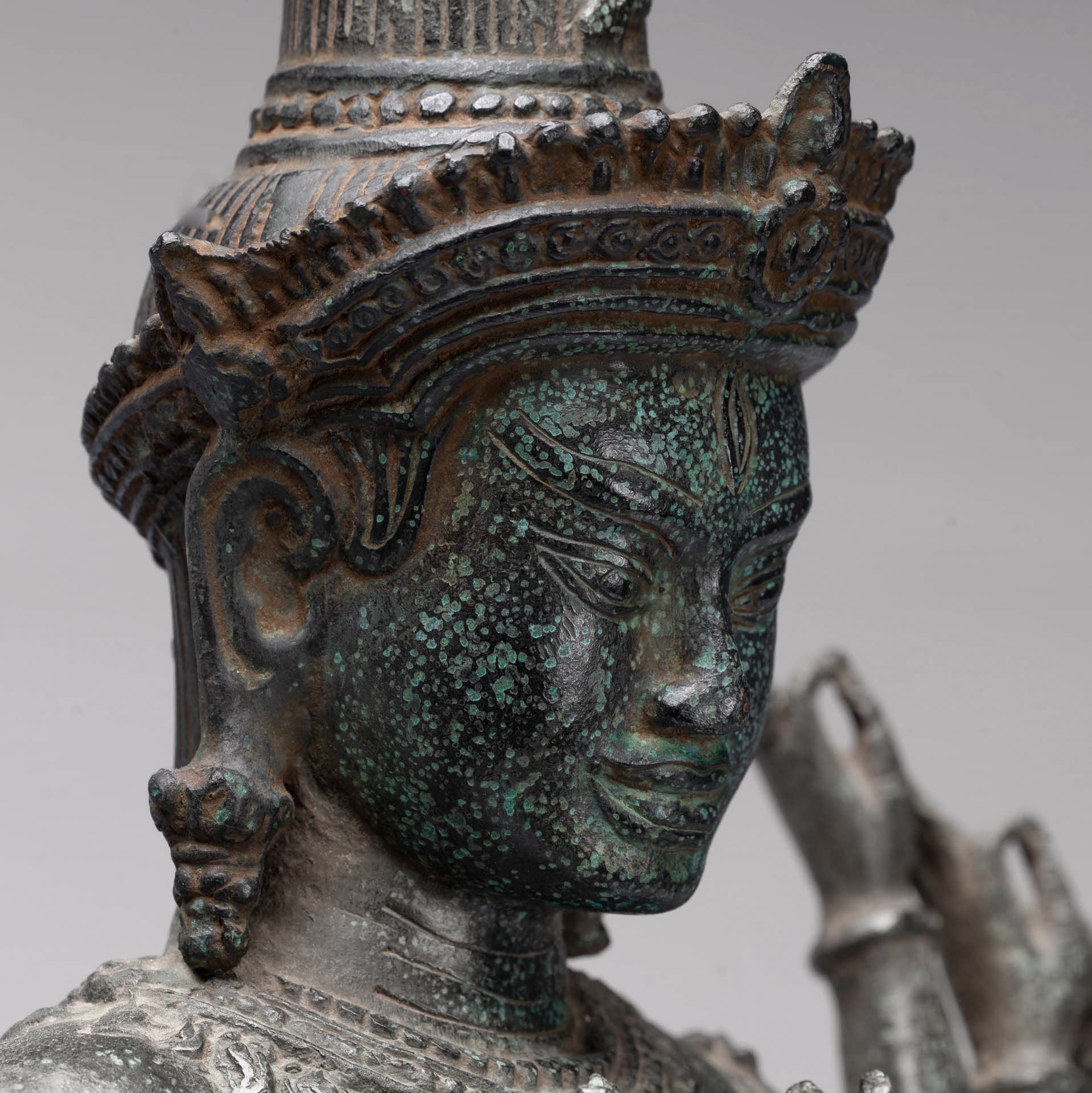-
Antique Khmer Style Bronze Bayon Ardhaparyanka Shiva - 10 Arms - 54cm/22"
Measures (Height) 54cm/22"
An antique Khmer 13th century Bayon style Ardhaparyanka Shiva.
In the rich pantheon of Hindu deities, Shiva stands out as a multifaceted figure, embodying roles ranging from the fierce destroyer to the compassionate benefactor. Among his many forms, Ardhaparyanka Shiva, the dancing form, holds a special place, encapsulating profound symbolism and deep spiritual meaning.
This depiction of Shiva combines the grace of dance with the unique characteristics of Shiva offering insights into the divine balance of activity and rest, creation and destruction.
A multi-armed Shiva in an exaggerated dancing ardhaparyanka pose characteristic of numerous Tantric deities, such as Hevajra. This suggests that the deity had a Tantric aspect for the Khmer, especially following the Angkor Wat period.
This Shiva image stands on a round bronze lotus leaf base. The lotus flower represents purity, compassion and the giving of great joy to all.
His hair is arranged in a cylindrical jata adorned with the symbol Om in raised relief. The deity is clothed in a long sampot can kpin with a scarf ending in a double pleated panel in front. The style of the sampot can kpin represents a later-thirteenth century revival of the Angkor Wat style.
Shiva is adorned with a diadem, earrings, armbands, bracelets, anklets, a pectoral with pendants at the back and a belt with marching pendants. The symbol Om is the most sacred mantra. The presence of the symbol Om suggests that this may be an image of Shiva as a yogin master. As the destroyer.
The Ohm symbol is shown on the front of the Lord's head as an ornament and the Trilochana of Shiva can be seen on his forehead - the Three-Eyed Lord. It is the eye of wisdom, free from “Maya”, the illusion, and duality of life. It is also believed to be the source of his untamed energy.
Shiva is regarded as limitless, transcendent and unchanging. Shiva is also regarded as the patron god of yoga, meditation and arts.
Ardhaparyanka Shiva, the dancing form of the god, offers a unique and profound perspective on the nature of the divine in Hinduism. This depiction emphasizes balance, tranquility, and the integration of dualities, conveying important spiritual lessons.
Though not as widely depicted as some other forms of Shiva, Ardhaparyanka Shiva remains a powerful symbol of cosmic harmony and spiritual wisdom, inviting devotees to reflect on the deeper meanings of rest, balance, and divine play in their own lives.
Through the graceful dance of Ardhaparyanka Shiva, we are reminded of the eternal rhythm of the universe and the delicate balance required to maintain harmony within and without. This form of Shiva encourages us to embrace both action and rest, to find joy in the cosmic dance, and to seek the divine balance that underlies all existence.
SATISFACTION GUARANTEE - We have been offering SE Asian Art for many years and are proud of the reputation we have developed for fair and honest listings. However, if for any reason, whatsoever, you are unhappy with your purchase please just let us know and we will provide a full refund. We want you to be 100% happy with your purchase.
-
The majority of orders will be shipped with DHL. This is a secure, express and fully tracked service.
Items less than 2Kg we typically ship using Royal Mail.
Once we receive your order we try to ship all orders the same or next working day.
Large and/or fragile pieces requiring palletising, specialist crating and/or extra packaging may take a little longer. Palletised shipments will be delivered curbside.
All orders over 35 GBP will be shipped free of charge.

-
We genuinely hope that all purchases delight.
However, if they do not, regardless of reason, we will refund all orders upon receipt of the unwanted item. Just notify us within 14 days of receiving your order that you wish to make a return and send the piece back to us with 30 days of delivery.
Gandhara Buddha statues mark a turning point in Buddhist art, where the Buddha was first shown in fully human form with a striking blend of Indian and Greco‑Roman aesthetics.
They are essential for understanding how Buddhism spread along the Silk Road and how visual culture translated spiritual ideas into a universal, approachable image.












































